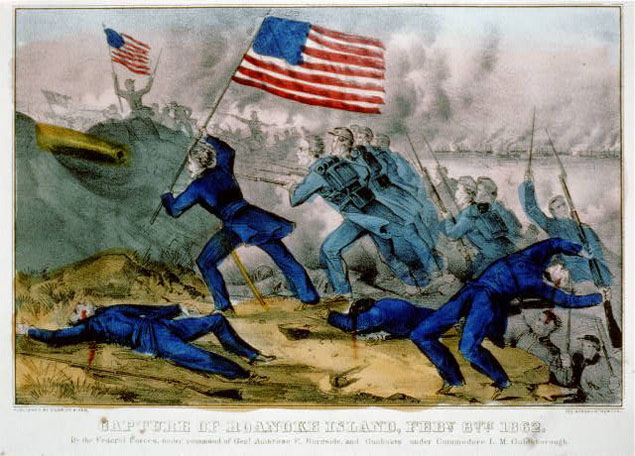
Library of Congress
Union forces set their sights on Roanoke Island, the linchpin in North Carolina’s coast, in early 1862. It was vital for Confederates to hold the island. If the Confederates lost Roanoke Island, it would only be a matter of time before Albemarle Sound, its port cities, and backdoor access to Norfolk would also be lost to the Union. Losing Roanoke Island would mean losing all of eastern North Carolina. Brigadier General Henry Wise, the Confederate commander on Roanoke Island, had no formal military training, but he recognized his vulnerable situation, pleading for reinforcements, but never receiving them.
Only one road ran north to south along the length of the island. Confederate troops built fortified earthworks on the road at the center of the island to defend against a land-based assault. Confederates also constructed forts on the northwest coast of the island, enabling cover of a water-based assault from the west. Union ships with their longer guns, came from the south, but remained easily out of range of all but the southernmost fort, which they quickly disabled.
Late in the afternoon of February 7, 1862, Union troops under Brigadier General Ambrose Burnside landed with the aim of assaulting the earthworks and road at the center of the island. The soldiers quickly captured the landing site and spent a wet night before the battle.
At dawn the Union troops successfully pushed through thick marshes to fire on the flanks of the earthworks while others attacked from the front. The Confederate troops were overwhelmed, fleeing to the north end of the island, where they ultimately surrendered Roanoke Island to the Union.
The fall of Roanoke Island opened eastern North Carolina to Union control. By the summer of 1862, the port cities of Plymouth, Elizabeth City, New Bern, Washington, Edenton, Hertford, N.C., and Norfolk, Va., had all fallen to Union forces. The vital rail line carrying supplies from Wilmington—North Carolina’s only remaining Confederate port—was also vulnerable. With the huge success at Roanoke Island, the Union stranglehold on the South was ever tightening.
Last updated: September 14, 2017
